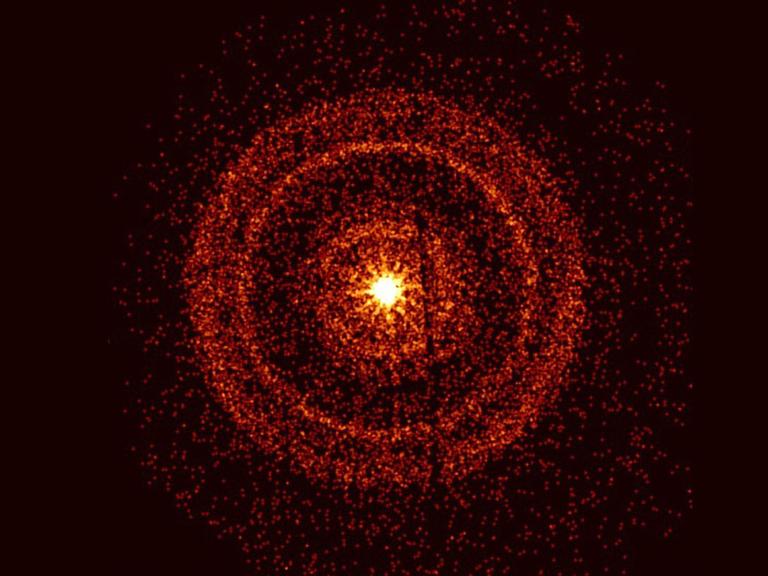
On Oct. 9, 2022, Swift’s X-Ray Telescope captured the afterglow of the brightest gamma-ray burst every recorded, called GRB 221009A. The bright rings form as a result of X-rays scattered from otherwise unobservable dust layers within our galaxy that lie in the direction of the burst Credit: NASA/Swift/A. Beardmore (University of Leicester). All Rights Reserved.
Brightest gamma-ray burst ever recorded may be 1-in-10,000-year event
Posted on March 29, 2023UNIVERSITY PARK, Pa. — On Sunday, Oct. 9, 2022, a pulse of intense radiation swept through the solar system. It was so exceptional that astronomers quickly dubbed it the “BOAT” — the brightest of all time. The source was a gamma-ray burst (GRB), the most powerful class of explosions in the universe.
The burst triggered detectors on numerous spacecraft, including the Neil Gehrels Swift Observatory, whose mission operations center is located at Penn State.
“When we first detected the burst, it was so bright and so close that we didn’t actually think it was a gamma-ray burst,” said Maia Williams, a research technologist at Penn State and a member of the Swift team. “But observations from NASA’s Fermi Gamma-ray Space Telescope and other observatories confirmed that this was indeed from a uniquely bright gamma-ray burst.”
After the initial detections, observatories around the globe followed up. After combing through all of this data, astronomers can now characterize just how bright it was and better understand its scientific impact.
“GRB 221009A was likely the brightest burst at X-ray and gamma-ray energies to occur since human civilization began,” said Eric Burns, an assistant professor of physics and astronomy at Louisiana State University in Baton Rouge. He led an analysis of some 7,000 GRBs detected by various observatories to establish how frequently events this bright may occur. Their answer: once in every 10,000 years.
Burns and other scientists presented new findings about the BOAT at the High Energy Astrophysics Division meeting of the American Astronomical Society in Waikoloa, Hawaii. Papers describing the results presented — including one describing Swift’s initial detection — will appear in a focus issue of The Astrophysical Journal Letters.
The signal from GRB 221009A had been traveling for about 1.9 billion years before it reached Earth, making it among the closest known “long” GRBs, whose initial, or prompt, emission lasts more than two seconds. Astronomers think these bursts represent the birth cry of a black hole that formed when the core of a massive star collapsed under its own weight. As it quickly ingests the surrounding matter, the black hole blasts out jets in opposite directions containing particles accelerated to near the speed of light. These jets pierce through the star, emitting X-rays and gamma rays as they stream into space.
As the jets continue to expand into space, they produce a multiwavelength afterglow that gradually fades away. William’s team found that the afterglow was more than 10 times brighter than that of any previous gamma-ray bursts observed by Swift.
In many cases, the exploding star also propels debris and other matter into space in a supernova, which should be detectable on Earth a few weeks after the initial GRB. There has been some debate amongst astronomers as to whether this supernova occurred, or if the star instead collapsed straight into the black hole without exploding. One reason the supernova has been challenging to detect is because the GRB occurred just a few degrees above the plane of our own galaxy, where thick dust clouds can greatly dim incoming light. However, using the sensitive Pan-STARRS optical ground telescope, the Young Supernova Experiment collaboration was able to spot the supernova.
“Pan-STARRS observations uniquely allowed us to see deeper in the redder part of the optical spectrum, which allowed us to see the supernova,” said V. Ashley Villar, Mercedes Richards Career Development Professor of Astronomy and Astrophysics, co-hire of the Institute for Computational and Data Sciences at Penn State and a member of the Young Supernova Experiment collaboration. “Our team plans to use the James Webb Telescope to further investigate the supernova and search for signatures of heavy element formation.”
The burst also enabled astronomers to probe distant dust clouds in our own galaxy. As the prompt X-rays traveled toward us, some of them reflected off of dust layers, creating extended “light echoes” of the initial blast in the form of X-ray rings expanding from the burst’s location. Swift’s X-ray telescope discovered the presence of a series of echoes. Detailed follow-up by the European Space Agency’s XMM-Newton telescope, together with Swift data, revealed these extraordinary rings were produced by 21 distinct dust clouds.
“How dust clouds scatter X-rays depends on their distances, the sizes of the dust grains, and the X-ray energies,” explained Sergio Campana, research director at Brera Observatory and the National Institute of Astrophysics in Merate, Italy. “We were able to use the rings to reconstruct part of the burst’s prompt X-ray emission, and also to determine where in our galaxy the dust clouds are located.”
GRB 221009A is only the seventh gamma-ray burst to display X-ray rings, and it triples the number previously seen around one. The echoes came from dust located between 700 and 61,000 light-years away. The most distant echoes — clear on the other side of our Milky Way galaxy — were also 4,600 light-years above the galaxy’s central plane, where the solar system resides.
This extraordinary gamma-ray burst helps provide a deeper understanding of how stars collapse and how black holes are born.
“This once in a lifetime event gave us a unique opportunity to study the death throes of a massive star in incredible detail,” said Jamie Kennea, research professor of astronomy and astrophysics at Penn State who leads the Swift Science Operations Team. “Thankfully, astronomers from around the world answered our call to arms, and the results have been amazing.”
